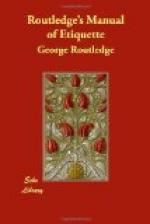[Illustration]
A green goose is carved much in the same way, but is not stuffed, and only the breast regarded as very delicate.
TURKEY
The prime part of the turkey is the breast, and it is only after this is exhausted that the real cutting up of the bird is required. The knife must be passed down close to the bone and through the forcemeat which fills the breast, and then thin slices, with a due portion of the forcemeat, distributed; and except in a very large party, this usually is sufficient; but if more be required, the pinions and legs must be taken off like those of the goose. The thigh is good; the pinion and drumstick are usually tough, and reserved till the last; the side or neck-bones are delicate; also the small round piece of flesh on each side of the centre of the back called the oyster. Beyond these the turkey requires no more carving.
A FOWL.
The fork must be firmly fixed in the centre of the breast, draw the knife along the line 1 to 3, and then proceed to take off the wing, by inserting the knife under the joint at 1, and lifting the pinion with the fork, drawing off the wing with a slice of the breast attached. The leg, cut round, is easily released in the same way. The merry-thought may next be detached by turning it back from the breast; the neck-bones which are beneath the upper part of the wings are easily raised. Then the breast must be divided from the back by cutting through the ribs close under the breast. The back may then be turned uppermost, press the point of the knife in the midst, and raise the lower end to separate it. Then remove the rump, and cut off the side bones which lie on each side of the back by forcing the knife through the rump-bone and drawing them from the back-bone; these side bones include the delicate morsel called the oyster. The breast and wings are the choice parts; the liver, which is trussed under one wing, should be divided to offer part with the other wing, the gizzard being rarely eaten; but the legs in a young fowl, and especially in a boiled fowl, are very good; the merry-thought too is a delicacy. If the fowl be very large, it is commonly carved like a turkey, with slices first cut from the breast. When a fowl is sent to table cold at luncheon or supper, it is often carved first and then neatly tied together with white ribbons. This looks well, and is very convenient in a large party.
[Illustration]
DUCK.
A duck, if large, must be carved as directed for a goose, by cutting slices from the breast, and afterwards removing the wings and legs; but if a very young bird, it is commonly disjointed first and then served in the same way as a fowl. The seasoned onions and sage placed under the apron may be removed with a spoon if required, but some have an objection to the strong flavour, and it is necessary to know that it is not disagreeable to them before you place it on the plate.




